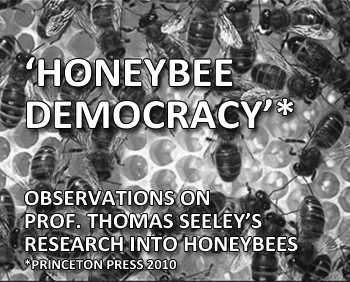Natural intelligence…a cogent stream of good sense for a colony of living organisms.
‘One of the popular misconceptions about honey bees is that their lives are ruled by a queen — or perhaps by even some more fanciful system. But in the forty years that I’ve spent studying bees, I’ve learned that their colonies are remarkably complex, in many ways comparable to an animal brain, despite being individually quite simple.
And every year, faced with the life-or-death problem of choosing a new home, honey bees stake everything on a process that includes collective fact-finding, vigorous debate, and consensus building. It is a democratic process that humans — especially office drones — might do well to emulate.
When a beehive becomes overpopulated, usually in the late spring or early summer, a few hundred scout bees, which are often the bees that have the most experience with the world beyond the hive, take off in all directions, searching for tree cavities. Each scout that discovers a promising site inspects it to see if it is suitably roomy and secure, and then returns to the cluster to announce her find by performing a waggle dance. The dance indicates both the location and the quality of the site.’
As the scouts report on their respective sites, other scouts observe and follow the directions to the indicated locations. Each scout inspects the site she navigated to and, if she agrees that is a desirable dwelling place, she too performs a waggle dance when she returns to the swarm.
Bees are thoroughly honest advertisers. The better she judges the site, the longer she dances, and the more effective she is in recruiting other scouts to make their own forays to the spot. This means that, despite the competing information that scouts bring back to the swarm, eventually, usually over a day or two, enough scouts will agree on the best site to cause them to induce the rest of the swarm to fly there.
Even though an individual bee is not particularly intelligent, the collective intelligence of the group produces impressive results. Almost always — about 90 percent of the time in my experiments — the swarm chooses the best of the options it has found.’
. …by Prof. Tom Seeley, author of “Honeybee Democracy” (Princeton Press 2010).
Observations
The lead group comprises researchers with shared interest, worldly experience, mutual respect and good dancing skills!
- They seek diverse solutions to the problem
- They aggregate the group’s research
- A quorum of researchers lead the colony
No Parties!…no Candidates!…no Leaders!…just diligent research and co-operative problem solving!!
Why can’t we do the same?!?
Luca Belgiorno-Nettis


